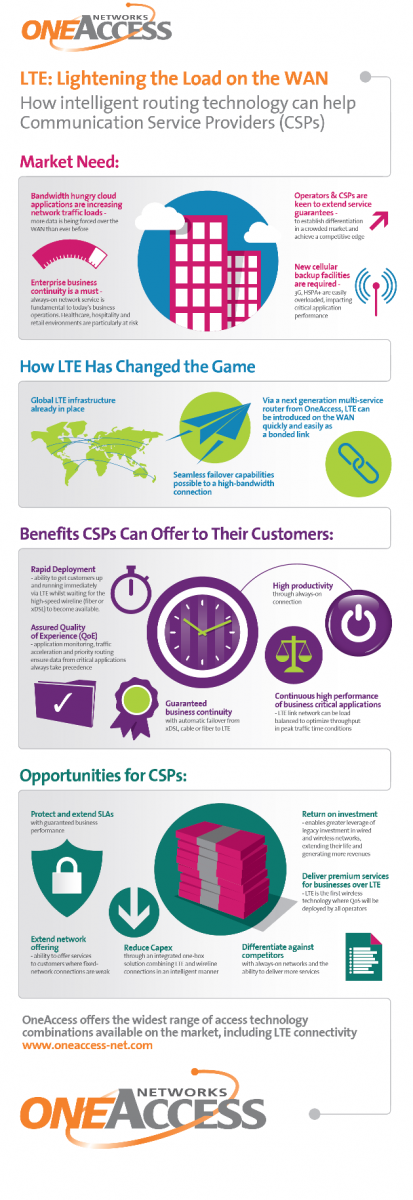Lift the lid on most ‘LTE in the enterprise’ discussions and it quickly becomes evident that LTE’s corporate mobility ‘revolution’ is in full effect. And rightly so.
Lift the lid on most ‘LTE in the enterprise’ discussions and it quickly becomes evident that LTE’s corporate mobility ‘revolution’ is in full effect. And rightly so. Dawn has well and truly broken on the IP/GSM-converged age of LTE and time-starved, frequent-flying execs across the world are now basking in the morning rays of the globally-supported, superfast standard.
But enterprise LTE should be about more than ensuring the CEO can get email on their iPad the next time they’re in Japan. What has, arguably, much further reaching implications for today’s enterprise (and has so far, been far less celebrated), is how else LTE can be put to use in the networked enterprise.
When used ‘behind the scenes’, for example, in unison with the organization’s other communications links, such as fiber, DSL and Wi-Fi, LTE has the power to help the entire enterprise WAN raise its game.
This means there are quick wins here for enterprise-focused telecom operators and communication service providers (CSPs), whose fixed line networks are already under strain from network equipment obsolescence and dramatic year-on-year hikes in data volumes. In a market dogged by falling ARPUs and increasingly complex network demands from customers, providers of enterprise WANs should not only welcome the chance to introduce an LTE link to their customers, they should be seizing the opportunity with both hands.
CSPs are perpetually seeking new ways to enhance their network performance, establish competitive differentiation and generate new revenues in order to offset the challenging market conditions. For them, LTE is a serious enabler. It can be used to boost whole-of-network performance, by intelligently load-balancing network traffic during peak usage times, for example, or by accelerating data throughput, or providing a beefier alternative to 3G for wireless backup, enabling a higher level of network performance as a result.
LTE is also opening up new market opportunities for service providers. Take, for example, the opening of a new branch office for an enterprise customer. This customer’s operations are heavily reliant on a high-speed fiber link, but due to engineering works required to lay fiber to the office, the service provider is forced to make them wait weeks, or worse, months, before they can reach optimal operational efficiency. The customer effectively has to run at half-speed, with critical applications and services unable to be fully deployed, resulting in a negative impact on business performance and market competitiveness. A dedicated LTE link can resolve this problem, providing fiber-like high bandwidth connectivity of up to 150Mbp/s almost immediately, meaning the business can get up and running at optimal capacity before the cabling guys have even begun to dig up the ground. When the fiber cabling is finally complete the LTE link can be retained as a best-of-breed link for data backup or to provide a business continuity failover option. These options then enable the CSP to extend their SLA guarantees to the customer and safeguard their relationship as a result.
How can a LTE link be provisioned so quickly? By redeploying a single piece of already-essential network equipment: the access router. Purpose-designed solutions, like the OneAccess One1540-4G, have transformed the router into a centrally managed platform over which service providers can deliver applications and bundles of revenue generating managed network services to enterprise customers, including the provision and management of bonded LTE as part of a multi-link hybrid-WAN model for enterprise connectivity. By doing so, service providers are able to quickly deliver the performance enhancements needed to future-proof their enterprise network offerings and, as we have seen, create opportunities to extend their SLA guarantees and establish market differentiation as a result.
OneAccess router platforms support the widest number of access technology combinations available on the market. This means operators and CSPs can ‘mass-customize’ their network access capabilities and drive down TCO through higher-volume purchases. A second TCO reduction factor is eliminating site visits: installing the same access platforms with all customers, and provisioning only the services and connectivity combinations required by each, greatly simplifies costly maintenance requirements.
Centralized access control and management is a trend that will only increase as demand for multi-link and Cloud-based enterprise connectivity solutions intensifies. The enabling potential of LTE, for both enterprise organisations and the service providers that support them, is vast. As always, the key lies in thinking laterally about how technology can be deployed most effectively. Those with the vision and courage to embrace the “4Gable” future stand to prosper the most.

Author:Jan Marien, Product Marketing Manager, OneAccess
